Feeding gestating sows
Optimum fertility rates are achieved during gestation, through balanced feeding and careful attention to the sows’ nutrient requirements for maintenance, foetal development and udder growth. The main goals during gestation are to ensure successful embryo implantation and litter development, to restore the sows’ body condition from a previous farrowing and all in all to get the sow fit and ready for the upcoming farrowing.
Production targets
- Successful conception and implantation
- Optimum uterine and maternal growth
- Achieving ideal body condition for the lactation period
Body condition & Weight
Well-conditioned sows will usually lose 5-20% of their body weight during lactation. At mating and early gestation, it is crucial to focus on the re-establishment body condition and ensure a positive energy balance for successful conception and implantation.
During the first four to five reproductive cycles, the sow is still growing. Meaning that it is common to see a weight increase from parity to parity, however the weight increase will decrease over time between parities as the body of the sow will be fully grown. Why it is not uncommon to see the weight increase to around 20 kg on average per cycle, and why a part of the supplied protein, and to a lesser extent energy will need to support both natural body development as well as litter and udder growth. When the sow is full-grown, the energy supply shifts to body maintenance as well as litter and udder growth.
Typical weight development for sows.
| Parity No. | At insemination, kg | At farrowing (kg)* | Avg. weight increase between parities, kg |
|---|---|---|---|
| 1 | 150 | 190 | |
| 2 | 160 | 205 | 30 |
| 3 | 180 | 225 | 25 |
| 4 | 200 | 240 | 15 |
| 5 | 220 | 260 | 10 |
| 6 | 240 | 280 |
* not including litter weight
Body condition score
Keeping a focus on ideal body condition throughout the full production cycle will support longevity and lifetime production. In case of a large weight loss in the farrowing unit, focus on compensating as quickly as possible, to increase the conception rate and optimise the number of Non-Productive Days (NPD). The target is to have as many sows as possible in an average body condition with a backfat thickness of 14-17 mm at farrowing.
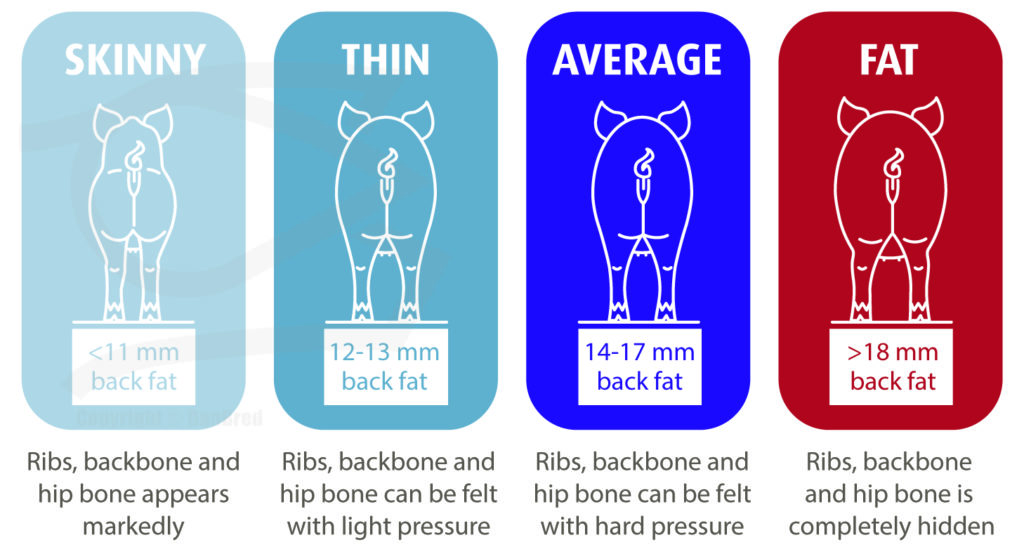
* measure backfat at the time of farrowing, when measured at the point P2.
Carry out a body condition evaluation for all sows at least four times during the production cycle:
| 1) | At the time of weaning or mating: This evaluation will pinpoint which feeding curve each sow should follow during early gestation. |
| 2) | At around day 30 of gestation: This evaluation makes it possible to change as many sows as possible to the normal feeding curve to save on feed and costs, and to avoid skinny sows becoming too fat. |
| 3) | At 70 days of gestation: This evaluation will indicate whether the feeding curves are optimal, and whether the remaining part of thin sows can follow the normal feeding curve until farrowing. |
| 4) | Just before farrowing: this evaluation will indicate if the chosen strategy was correct, and whether the feeding curves should be revised. It also provides information to decide if additional measurements should be taken to support body condition during lactation. |
<!–
- At the time of mating: This evaluation will pinpoint which feeding curve each sow should follow during gestation.
- At pregnancy control and after 70 days of gestation: these evaluations will indicate whether the sows are following the correct feeding curve or if it needs adjustment.
- Just before farrowing: this evaluation will indicate if the chosen strategy was correct, and decide if extra measurements should be taken to support body condition during lactation.
–>
Different methods can be used for the evaluation of body conditions. Always use a combination of these methods when assessing body condition, and never rely on visual evaluation alone.
- Visual evaluation – simply look at each sow
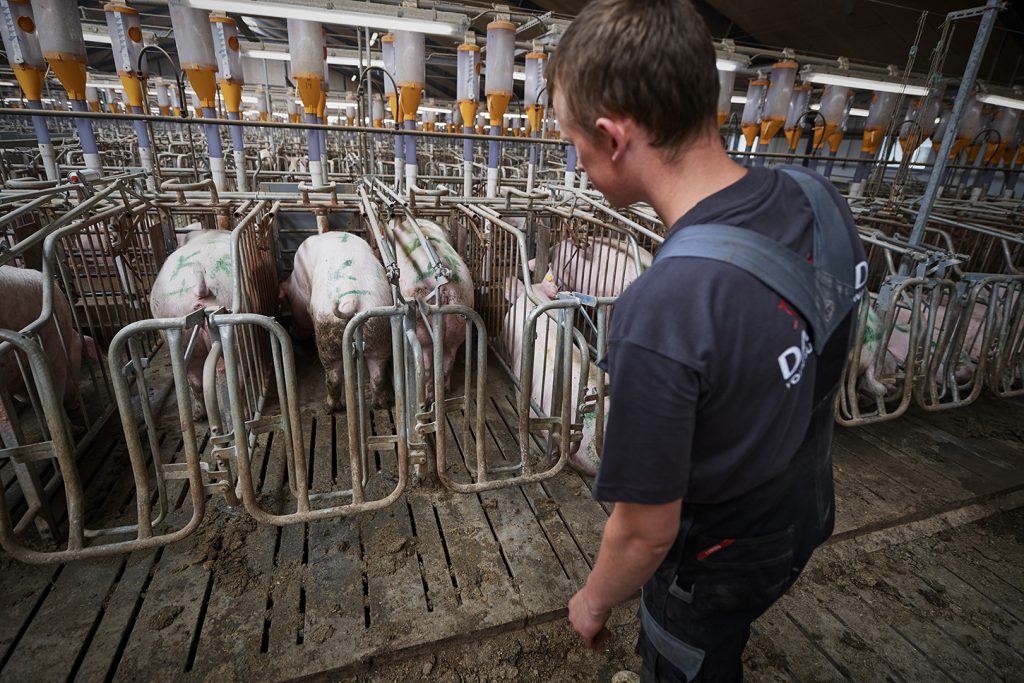
- Palpation – use your hands to check the body
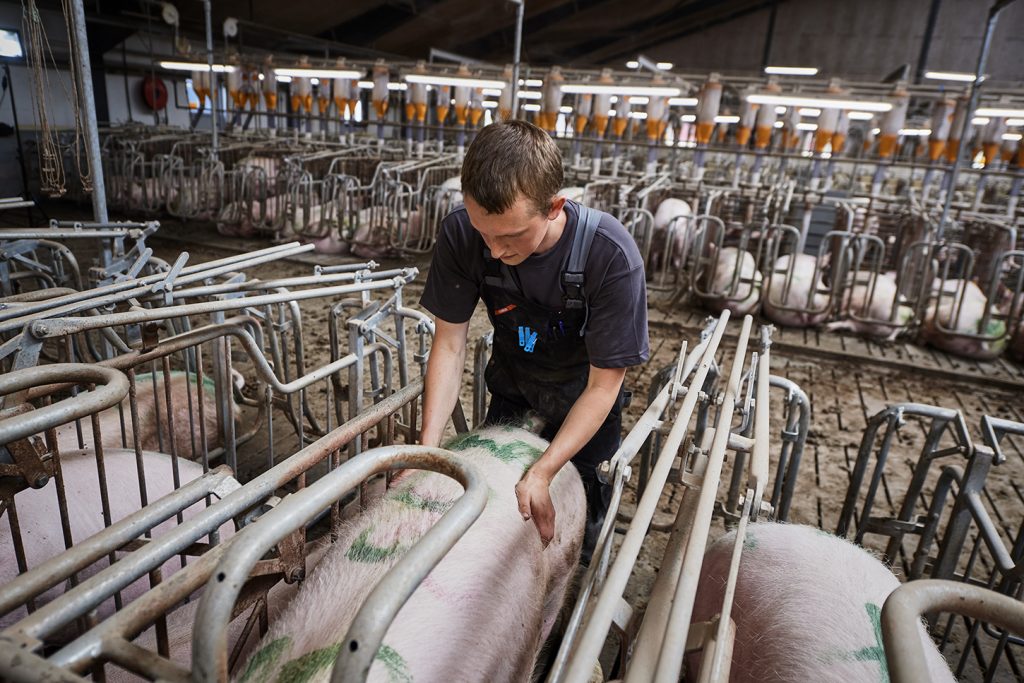
- Measurement of the backfat thickness.
|
|
|
Feeding method
Feed gestating sows according to their individual needs. If group feeding the sows is the only option available, it is vital to focus on:
- Equality in the groups: sort the sows according to body condition
- Maintain body condition: ensure the groups stay homogeneous
- Keep thin sows apart from the groups: individual pens ideally

Nutrient requirements
The basic nutritional requirements for DanBred sows are described below. The requirements are based on production in a temperate zone, adaption for the relevant climate may be necessary.
| Energy, per kg feed | |
|---|---|
| MJ ME/kg feed | 12.5 |
| MJ NE/kg feed | 9.4 |
| Danish Feed Units (FU) sow/kg | 1.02 |
| Relations between MJ ME/MJ NE are depending on feed ingredients | |
| Basic nutrients, digestible per kg | |
| SID protein. min. g/kg | 95 |
| Lysine, SID g/kg | 4.2 |
| Digestible phosphorus g/kg | 2.1 |
| Calcium, g/kg (at 0 FTU phytase) | 7.1 |
Mineral and vitamin supply should be adequate to ensure optimal litter development and general health. Soluble, as well as insoluble fibres, should be added to maintain gut health.
The full nutrient tables can be found here.
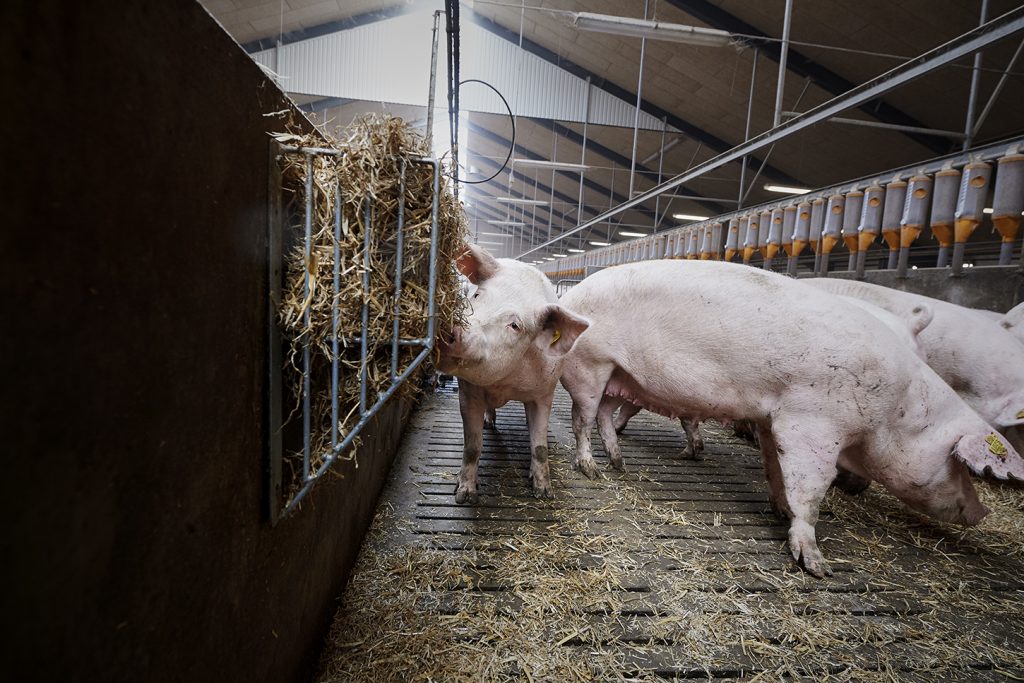
Feeding strategy
Careful attention to feeding, especially in the first 4 weeks after insemination, will optimise litter size. And remember when we are talking about feeding curves over time, adjustments to these feeding curves should be made gradually, so make sure to adjust the feeding curves over 3-5 days to make sure the sows keep eating.
| Guideline feed curves for sows during gestation (kg per day)¹ | ||||
|---|---|---|---|---|
| Days post-mating | Guideline feed allowance based on body condition score and backfat thickness at weaning or mating | |||
| Skinny < 12 mm | Average 12-14 mm | Fat > 14 mm | Gilts | |
| 1-28 | 4.3 | 2.9 | 2.4 | 2.2 – 2.4 |
| 29-84 | 4.3 | 2.3 | 2.3 | 2.4 – 2.6 |
| 85-115 | 3.9 | 3.4 | 3.4 | 3.3 |
| 116-117*,** | 3.0 | 3.0 | 3.0 | 3.0 |
1 Daily feed allowances are based on a diet with an energy density of 9.5 MJ NE/12.5 MJ ME/1.05 EW with a content of around 4.12g SID lysine per kg feed.
* In general 3,4 kg of feed should be provided until farrowing, and a decrease to 3,0 kg at day 116 should be used only if the prevalence of MMA is too high.
** For sows older than second parity the feeding level on day 116-117 should not be decreased as 3.4-3.8 kg of feed per day has been shown to reduce the proportion of stillborn piglets.
*** A skinny sow should be moved to the average curve as soon as the body condition is re-established, otherwise there is a risk of sows becoming too fat.
In the first 4 weeks after insemination, the feed allowance should be 2.4 to 4.3 kg per day for sows, depending on body condition. This period is considered ideal for restorage of backfat in sows skinny at weaning, and hence these are fed a very high feeding level. Small gilts should be fed around 2.2 kg per day and heavy gilts around 2.4 kg per day. Avoid ad-libitum feeding of gilts at this stage as studies have shown that careful attention to feeding, in this first period after insemination, will optimise litter size, due to better implantation and initial embryo growth.
The second stage of gestation (28-84 days) is when it is also possible to recover previously lost body condition. The feed allowance should be adjusted based on the current body condition.
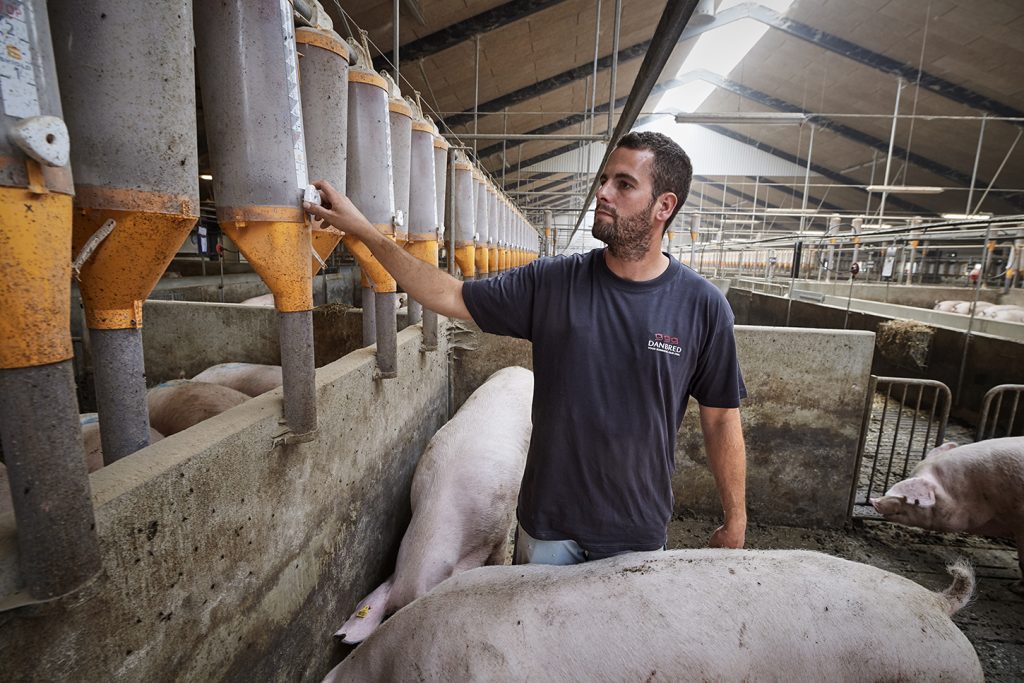
In the last stages of gestation, the feeding curve must be adjusted to reach the optimum weight at farrowing. For normal and slightly fat sows an increase in feed allowance up to 3.4 kg per day in the last 3-4 weeks of gestation will contribute to better development and growth of the piglets. If there are still sows categorized as skinny at this point, adjustments should be made to the management of body condition and feeding curves should be revised if needed. Skinny sows should be minimised at this time, and solutions to this problem should be found earlier on in gestation. However in unique circumstances sows can/will still be skinny at this stage, and these sows should have special focus and attention with a feed allowance just below 4 kg per day.
Just before farrowing, it is recommended to reduce the feed allowance for first and second parity sows to physically increase the space available in the birth canal. Adjust the energy level, to boost the energy status before the exhausting farrowing. However, recent research has shown that keeping the feed allowance at 3.4-3.8 kg per day for sows older than second parity, can improve the farrowing performance and reduce the need of farrowing assistance.
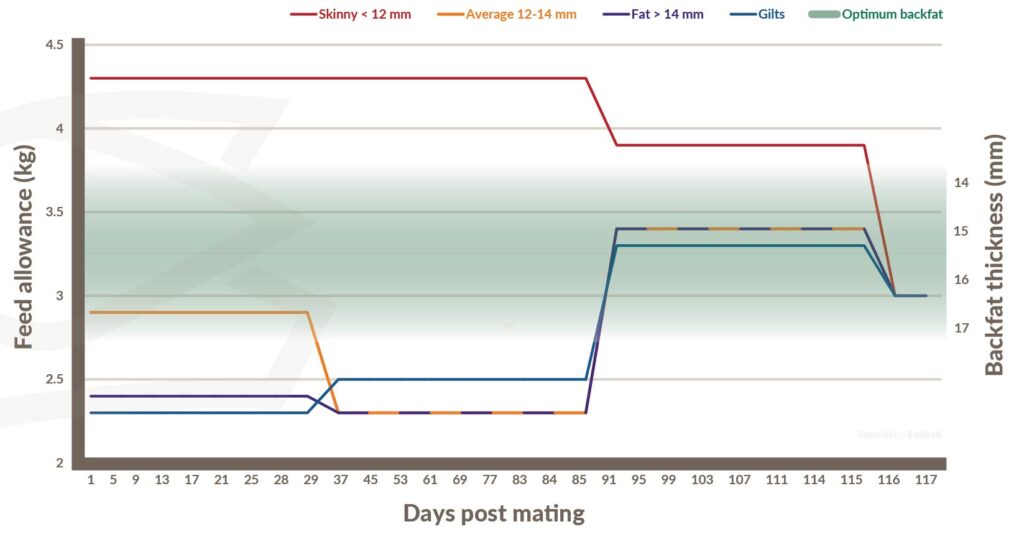
Environmental factors
The environment such as temperature, humidity and in-house airspeed can influence feed consumption.
Low indoor temperature increases the energy requirement for sows, which is especially important to remember when feeding lean sows.
The optimal temperature for gestations sows is 20°C. Every 5°C decrease starting from 20°C will require an additional 0.2 kg feed per day.
On the contrary high temperatures reduce feed intake. It can be an advantage to feed during the night as well as adjust the energy content for optimised energy supply and thereby ensure the sow’s ability to adequately recover from farrowing.
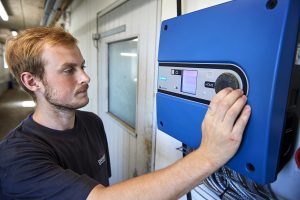 |
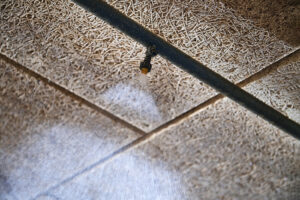 |
| Systems to adjust ambient temperatures are imperative for optimised feeding as well as general animal welfare. | |
The above, emphasises that an individual assessment of sow condition and subsequent adjustment of the feeding rate is of great importance for achieving the best possible results in the farrowing unit.


